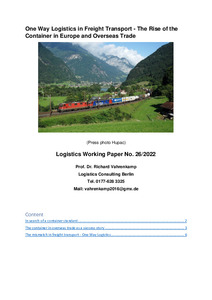One Way Logistics in Freight Transport
| dc.date.accessioned | 2023-09-15T08:24:18Z | |
| dc.date.available | 2023-09-15T08:24:18Z | |
| dc.date.issued | 2022 | |
| dc.identifier | doi:10.17170/kobra-202309128759 | |
| dc.identifier.uri | http://hdl.handle.net/123456789/15076 | |
| dc.language.iso | eng | |
| dc.rights | Urheberrechtlich geschützt | |
| dc.rights.uri | https://rightsstatements.org/page/InC/1.0/ | |
| dc.subject | St. Étienne | ger |
| dc.subject | Hamburg | ger |
| dc.subject | Rotterdam | ger |
| dc.subject | Hupac | eng |
| dc.subject | coal | eng |
| dc.subject | oil amphora | eng |
| dc.subject | Tours | eng |
| dc.subject | Angers | eng |
| dc.subject | Nantes | eng |
| dc.subject | unpaired transports | eng |
| dc.subject | one way logistics | eng |
| dc.subject | pairing index | eng |
| dc.subject | container | eng |
| dc.subject | palettes | eng |
| dc.subject | railway | eng |
| dc.subject | railroad | eng |
| dc.subject.ddc | 650 | |
| dc.title | One Way Logistics in Freight Transport | eng |
| dc.type | Working paper | |
| dcterms.abstract | The European railroad companies founded the International Container Bureau in Paris in 1933. The Swiss company Hupac successfully developed container transport with transalpine freight transport by rail between Germany and Italy. In the 1930s, Europe and the U.S. had agreed on a common ISO standard for 20 foot containers and 40 foot containers, so that empty containers could be exchanged between the various shipping companies in the global supply chains. But this standard is not compatible with the metric system of European palettes used in trains and trucks. Container handling in Northern European ports developed into a classic success story, reflecting the decline of consumer goods industries in Europe. Articles of consumer electronics and textiles were produced in Asia and brought to Europe by container ships. Globalization required special import logistics for container transshipment in the ports of Northern Europe, and distribution logistics linked to this, with hinterland transport by railroads, but also by trucks. At the port of Hamburg, throughput (import and export containers combined) grew steadily from 2 million TEU in 1990 at an average rate of 10% p.a. to nearly 10 million TEU in 2008. The shipping companies discriminated against the European ports on the Mediterranean because of poor services for unloading containers. Examples of unpaired transports and one way logistics are the deliveries from the coal mining area of St. Étienne via the river Loire to the big cities on the lower river, such as Tours, Angers or Nantes in the 19th century. In the 1920s occurred unpaired traffic at goods transport of the German railway. 27% of the axle kilometres had been driven empty. The pairing index of a port is defined as the percentage of imports containers over the sum of imports and exports containers. The pairing index of the port of Hamburg is calculated for the years 1990 to 2014. The stability of the pairing index of 51,72% rises new questions for research. | eng |
| dcterms.accessRights | open access | |
| dcterms.creator | Vahrenkamp, Richard | |
| dcterms.extent | 8 Seiten | |
| dc.contributor.corporatename | Kassel, Universität Kassel, Fachbereich Wirtschaftswissenschaften | |
| dc.subject.swd | Saint-Étienne | ger |
| dc.subject.swd | Hamburg | ger |
| dc.subject.swd | Rotterdam | ger |
| dc.subject.swd | Tours | ger |
| dc.subject.swd | Angers | ger |
| dc.subject.swd | Nantes | ger |
| dc.subject.swd | Güterverkehr | ger |
| dc.subject.swd | Logistik | ger |
| dc.subject.swd | Container | ger |
| dc.subject.swd | Palette <Logistik> | ger |
| dc.subject.swd | Eisenbahn | ger |
| dc.subject.swd | Eisenbahnlinie | ger |
| dc.title.subtitle | The Rise of the Container in Europe and Overseas Trade | eng |
| dc.type.version | publishedVersion | |
| dcterms.source.series | Logistics Working Paper | eng |
| dcterms.source.volume | No. 26/2022 | |
| kup.iskup | false |
Dateien zu dieser Ressource
Das Dokument erscheint in:
-
Publikationen [14]

